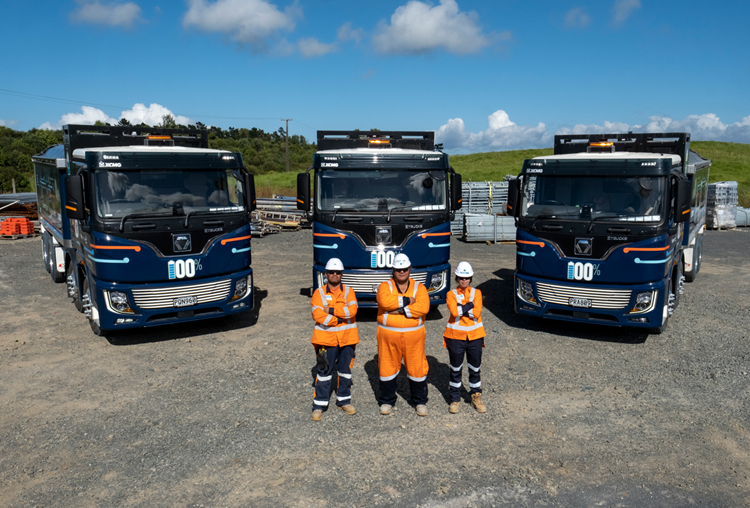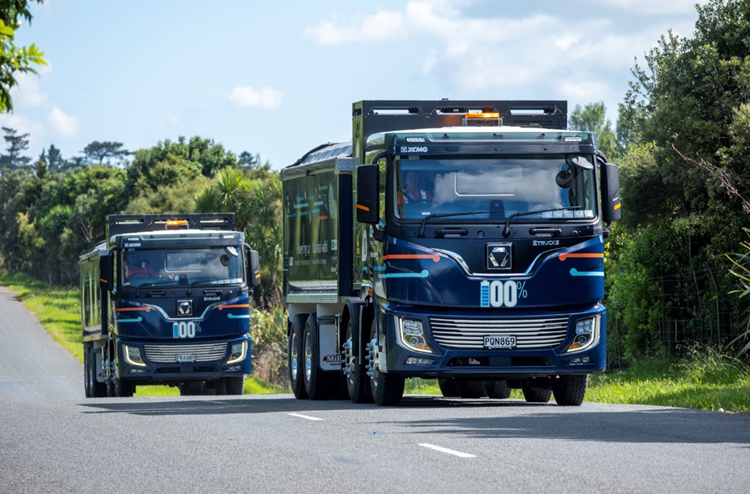
The Central Interceptor project is constantly looking for new ways to improve sustainability in all aspects of construction. So, we’re charging ahead, making our heavy vehicle fleet greener with the arrival of three new electric tipper trucks.
We have purchased the new electric tipper trucks thanks to $500,000 received in funding from the Energy Efficiency and Conservation Authority (EECA). They are believed to be the first electric on-road tipper trucks with battery swapping capability in New Zealand.


Photos: Kua whai wāhi hiko ki te ao hanganga. Powering up in the construction industry.
Our E-trucks were manufactured in China by XCMG, a leading global E-truck manufacturer. After extensive testing in Auckland, the trucks were sent to Rotorua where a truck trailer manufacturer designed and installed the tipper bodies. They have a six-speed fast change automatic transmission with an average range of 200km. (In comparison, a new 1.8L Toyota Corolla has around 104kw of power).
The E-trucks run entirely on 2800kg batteries that can be swapped out for one of our spares in 5-10 minutes. It would take a similar amount of time to refuel a diesel truck. Our 180kw battery charger can charge one battery in 90 minutes and two in three hours.
These E-trucks are primarily being used for moving spoil from Central Interceptor shafts and tunnels to Puketutu Island in Māngere. We are supporting the restoration of the area by re-filling the former quarry with spoil removed from our construction sites.
The vehicles have a 13-tonne load carrying capacity and weigh 26,000kg when fully loaded. They will transport more than 66,000 tonnes of spoil from Central Interceptor sites throughout the project. This will reduce project emissions by more than 300 tonnes in total. This is the equivalent of driving from Cape Reinga to Bluff more than 800 times.
E-trucks produce 79% less carbon than diesel trucks. This is the equivalent of powering 400 homes for a year. Every 100,000km travelled by our trucks will save 50,000 litres of diesel.
Not only are E-trucks more efficient but they are also much quieter than diesel trucks. This is a huge bonus as many of our sites are in residential areas.

 Photo: They will transport more than 66,000 tonnes of spoil from Central Interceptor sites throughout the project.
Photo: They will transport more than 66,000 tonnes of spoil from Central Interceptor sites throughout the project.
Our new E-trucks look a bit different from the standard diesel construction truck.
For a start, they are painted a smart navy-blue colour and they also feature unique designs that were developed in association with Watercare's Mana Whenua Kaitiaki Managers Forum.
The Central Interceptor wastewater tunnel will significantly improve the health of waterways and beaches in central Auckland by drastically reducing wet-weather overflows. The $1.2b project involves 16 construction sites and around 500 staff. By transporting excavated material, the E-trucks play their role in helping to leave a legacy of a cleaner city for future generations. This helps to establish a whakapapa for the truck and embraces the core values of Kaitiakitanga, which involves guardianship and protection for the natural environment and resources.
The artwork includes fossils and shells, in reference to ancient natural artefacts, such a whale bones, stingray teeth and flax snail shells that were discovered during early excavation at the Māngere construction site. On the back of the trucks, you’ll see drawings of a family and water drops - as water is precious, and the Central Interceptor tunnel will benefit future generations.
We try to ensure that native fauna and flora are protected from our construction activities, so you may spot skink and leaf drawings, which refer to our gecko/skink re-location work, plus tree-planting activities.
Wavy lines reference Watercare’s heritage as a provider of clean water and highly treated wastewater. They also symbolise a linear process of identifying a problem (dirty waterways due wet-weather overflows caused by old infrastructure); to action (construction of the Central Interceptor wastewater tunnel;) to a solution (cleaner waterways).
Finally, each truck has a QR code which links you to our Central Interceptor homepage.